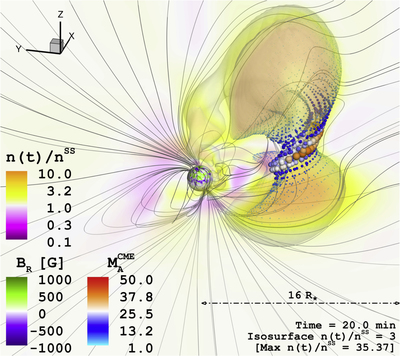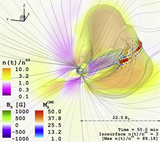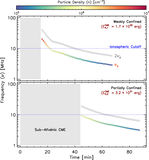Image Details

Caption: Figure 3.
Snapshot during the temporal evolution of the weakly confined CME (﹩{E}_{{\rm{B}},1}^{\mathrm{FR}}\simeq 4.1\times {10}^{35}﹩ erg, ﹩{E}_{{\rm{K}},1}^{\mathrm{CME}}\simeq 1.7\times {10}^{32}﹩ erg, ﹩{M}_{1}^{\mathrm{CME}}\simeq 9.4\times {10}^{15}﹩ g) within our M-dwarf simulation. The stellar surface is color-coded (purple-green) by the radial magnetic field driving the ambient AWSoM solution. A secondary color scale (magenta-yellow) denotes the density contrast, n(t)/nSS, which is used to trace the CME front by the indicated isosurface. The nominal shock condition, calculated from the Alfvénic Mach number of the CME front (﹩{M}_{{\rm{A}}}^{\mathrm{CME}}﹩, Equation (1)), is encoded simultaneously by the size of the scatter distribution (spheres) and by a tertiary color scale (cyan-red). The field of view is 32 R★, with a set of selected large-scale magnetic field lines in gray.
Copyright and Terms & Conditions
© 2020. The American Astronomical Society. All rights reserved.








